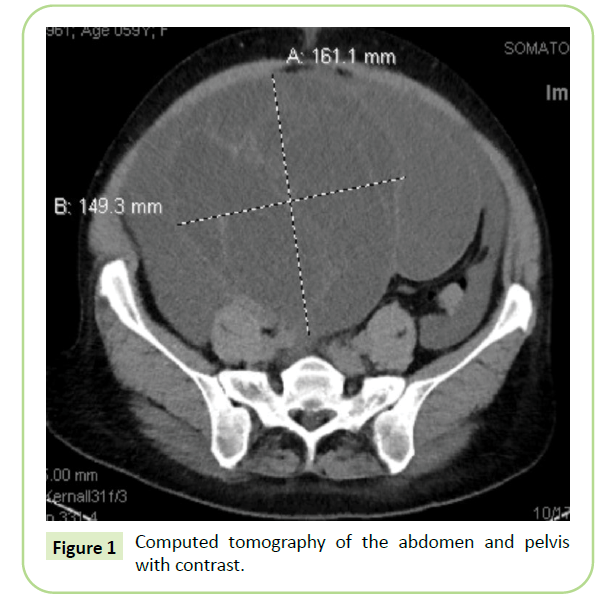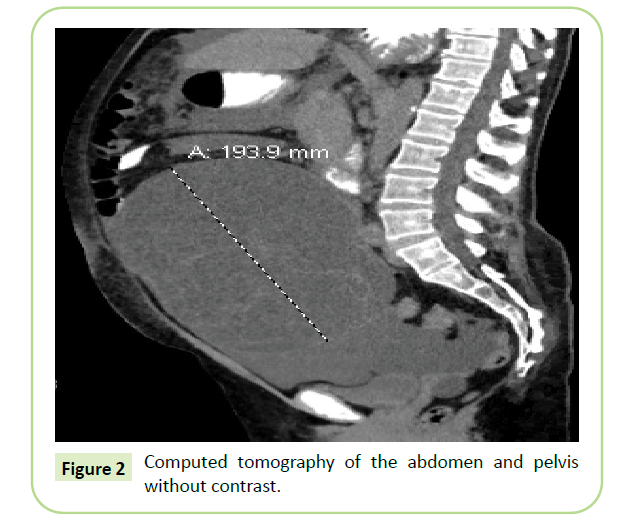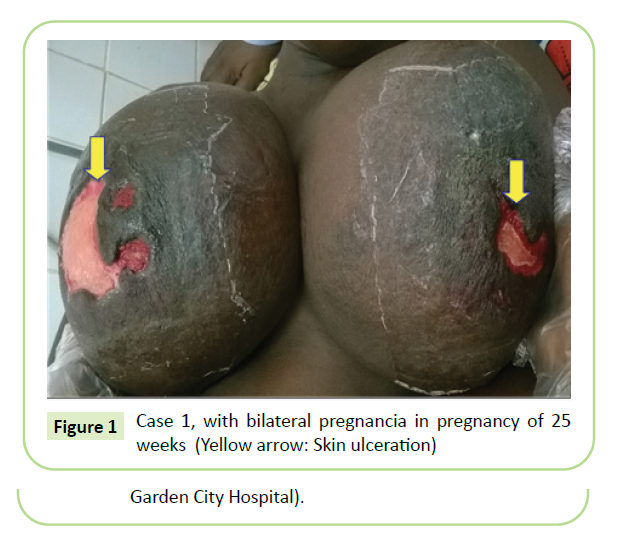Hall H*, Weirich E, Gruda A, Haddad C, Malviya V and Chang CY
Department of Gynecology and Obstetrics, Garden City Hospital, Garden City, Michigan, USA
- *Corresponding Author:
- Heather Hall
Department of Gynecology and Obstetrics,
Garden City Hospital, 6245 Inkster Road,
Garden City, Michigan-48135, USA.
Tel: +1-4178405388
E-mail: heatherhalldo@gmail.com
Received Date: June 23, 2021; Accepted Date: July 14, 2021; Published Date: July 22, 2021
Citation: Hall H, Weirich E, Gruda A, Haddad C, Malviya V, et al. (2021) Revisiting Meigs Syndrome: A Typical Case Report. Gynecol Obstet Case Rep Vol.7 No.8:146
Keywords
Benign ovarian mass; Fibroma; Cystadenofibroma; Pleural effusion;
Ascites; Meigs syndrome
Introduction
Meigs Syndrome is characterized by the triad of pleural effusion,
ascites, and ovarian fibroma. It is a rare syndrome that occurs
in approximately 1% of cases of an ovarian mass [1,2]. Pseudo-
Meigs syndrome has also been reported with other ovarian
masses, but true Meigs Syndrome is associated with an ovarian
fibroma. By definition, pleural effusion and ascites in Meigs
Syndrome subside after resection of the associated ovarian
mass [3-5]. Symptoms of ovarian mass may predominate patient
presentation including bloating, palpable pelvic mass, bowel or
urinary obstruction, early satiety, weight gain, or weight loss.
The patient may also present with symptomatic pleural effusion
and/or ascites including shortness of breath, bloating, abdominal
distention, or abdominal pain. The clinical picture of Meigs
syndrome-an ovarian mass in the setting of ascites and pleural
effusion can lead clinicians to strongly suspect malignancy.
However, Meigs syndrome is a benign condition in which pleural
effusion, ascites, and abnormal fluid will resolve with the removal
of the mass [6].
Case Report
A 59-year-old G5P2032 with a past medical history significant for
hypothyroidism, gastroesophageal reflux disease, and chronic
constipation initially presented to the emergency department complaining of feeling a mass within her pelvis. The patient
reported rapid enlargement of the mass over approximately
nine months associated with early satiety and weight loss. Her
prior surgeries included remote open cholecystectomy and
hysterectomy for abnormal uterine bleeding about fifteen years
prior.
The clinical exam was significant for no acute distress, nonlabored
respirations, lungs clear to auscultation bilaterally,
abdomen distended with a palpable fluid wave, and bimanual
exam with limited findings secondary to ascites, however, a large
palpable pelvic mass was noted up to the level of the umbilicus.
Diagnostic assessment
Computed tomography of the abdomen and pelvis with and
without contrast showed moderate ascites, heterogeneous liver
parenchyma, and a large septated and mid-pelvic lesion 16 cm
× 15 cm. Free fluid was noted within the pelvis. The patient
underwent paracentesis with the removal of approximately
four liters of yellow mucinous fluid. The ascitic fluid cytology
was negative for malignancy. A 19 cm × 20 cm septated pelvic
mass was noted on ultrasound at the time of paracentesis. It was
determined that the patient should undergo surgical resection of
the ovarian mass to allow pathological diagnosis (Figures 1 and 2).
Therapeutic intervention
The patient underwent an exploratory laparotomy with a
gynecologist and a gynecologic oncologist. Two liters of fluid
were removed from the abdomen and sent to pathology. The
right ovary and mass were resected and sent to pathology for
a frozen section. Preliminary results of the frozen specimen
showed a benign mucinous cyst. Due to its size and mucinous
nature, the decision was made to perform a subsequent right
salpingectomy, left salpingectomy, left oophorectomy, and
appendectomy. Performing an appendectomy was of the utmost
importance clinically given the mucinous nature of the tumor.
Omental biopsies were also taken. The estimated blood loss was
150 ml. The patient tolerated the procedure well, recovered from anesthesia in the post-anesthesia care unit, and stayed two nights
in the hospital for recovery and monitoring. She was meeting all
postoperative milestones and was discharged home in stable
condition on postoperative day two. Two days postoperatively,
an X-ray of the abdomen showed trace pleural effusion of the left
lung, and an ultrasound for a survey of ascites showed a minor
amount of fluid within the abdomen two days postoperatively. At
her postoperative appointment, the patient had recovered well
from the procedure. Her incision was well-healed. She had no
further accumulation of ascites and no pulmonary symptoms. Six
months after the procedure, the patient was doing well without
any sequelae from the procedure or Meigs syndrome.
Figure 1: Computed tomography of the abdomen and pelvis with contrast.
Figure 2: Computed tomography of the abdomen and pelvis without contrast.
Figure 3: Mucinous neoplasm with mild epithelial proliferation
or stretched flat surface from distended secretions,
occasional more imagined proliferation and rare
papillary tufted growth. (Image courtesy: Dr. Chang,
Garden City Hospital).
Final pathology
The final pathologic report was significant for a 19 cm × 18.5 cm
× 8 cm cystic ovary with a relatively smooth external smooth
with occasional small foci of adhesion. Opening the ovary
revealed multiloculated cysts of variable sizes ranging from a
few millimeters to about 10 cm in the largest cyst which were
predominantly translucent, viscous, and mucoid. Microscopic
sections confirmed the diagnosis of benign cystic mucinous
cystadenofibroma without any nuclear or cytological atypia
identified. Macroscopic examination of the ascitic fluid removed
during the surgery showed cloudy yellow fluid. Microscopic
examination showed no evidence of malignancy (Figure 3).
Discussion and Conclusion
While the incidence of cystadenofibroma is unknown, it is
estimated to account for approximately 1.7% of all benign ovarian
neoplasms [7]. At the time of surgery, these masses have a gross
appearance of malignant tumor with solid and cystic components
necessitating the need for a frozen section at the time of surgery
[8]. Mucinous components of ovarian masses often make
preliminary pathologic diagnosis difficult as mucinous tumors are
often heterogeneous in nature requiring multiple frozen sections to be made at the time of resection [9]. Mucinous tumors are
notoriously difficult tumors in which to rule out malignancy.
Mucinous tumors also require the additional intervention of an
appendectomy [10].
Meigs syndrome typically presents with symptoms that greatly
affect the quality of life and raise significant suspicion for
malignancy. Clinicians need to recognize Meigs syndrome as
a possible benign cause each time the constellation of pleural
effusion, ascites, and an ovarian mass is encountered. The proper
surgical treatment and timely management of this syndrome will
significantly improve the patient’s quality of life.
Conflicts of Interest
The authors whose names are listed above certify that they have no affiliations with or involvement in any organization or entity
with a financial interest or non-financial interest in the subject
matter or materials discussed in this case report.
Funding Statement
This research received no specific grant from any funding agency
in the public, commercial, or not-for-profit sectors.
Patient Consent
Informed written consent for publication of this case report from
the patient obtained. The completed consent form is available
upon request.
References
- Budicin JC, Marine WC (1962) Jr. Meigs' syndrome: Report of a typical case. Calif Med 96: 277-280.
- Mohammed SA, Kumar A (2021) Meigs syndrome. StatPearls Publishing, Florida, USA.
- Saha S, Robertson M (2012) Meigs' and Pseudo-Meigs' syndrome. Australas J Ultrasound Med 15: 29-31.
- David R, Daniel G (2103) Ovarian mass, pleural effusion, and ascites. J Bronchol Int Pulmonol 20: 48-51.
- Meigs JV, Cass JW (1937) Fibroma of the ovary with ascites and hydrothorax. Am J Obstet Gynecol 33: 249-326.
- Kortekaas KE, Pelikan HM (2018) Hydrothorax, ascites and an abdominal mass: not always signs of a malignancy: Three cases of Meigs' syndrome. J Radiol Case Rep 12: 17-26.
- Cho SM, Byun JY, Rha SE, Jung SE, Park GS, et al. (2004) CT and MRI findings of cystadenofibromas of the ovary. Eur Radiol 14: 798-804.
- Compton HL, Finck FM (1970) Serous adenofibroma and cystadenofibroma of the ovary. Obstet Gynecol 36: 636-645.
- Wasnik A, Elsayes K (2010) Ovarian cystadenofibroma: A masquerader of malignancy. Indian J Radiol Imaging 20: 297-299.
- Rosendahl M, Oester LA, Hogdall CK (2017) The importance of appendectomy in surgery for mucinous adenocarcinoma of the ovary. Int J Gynecol Cancer 27: 430-436.




